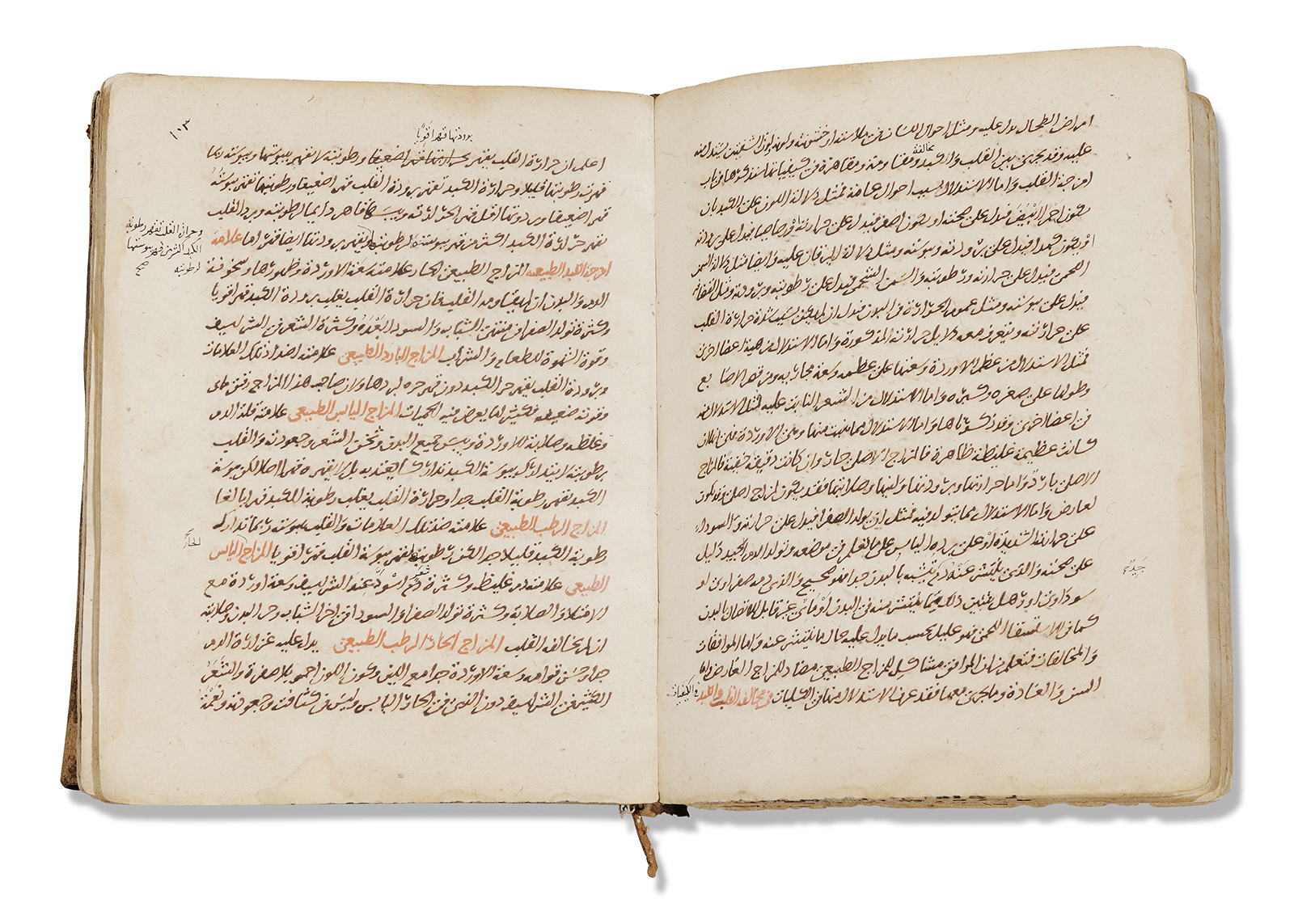Click on the image to zoom
Ibn Sina’s Canon of Medicine, (Qanun [Fi’l-Tibb] of Ibn Sina), Vol. 4
- Accession Number:AKM511
- Creator:Author (of original text): Ibn Sina, Persian, 980 - 1037
- Place:Iran or Iraq
- Dimensions:24 cm × 19.4 cm × 3.6 cm
- Date:1073
- Materials and Technique:Opaque watercolour and ink on paper.
-
This object is included in the following tour(s):
Stop #1 of Audio Guide: AchievementClick below to listen (Audio Guide: Achievements - Introduction & AKM 511)
Next up in the Achievement Tour:
More About Ibn Sina’s Canon of Medicine, (Qanun [Fi’l-Tibb] of Ibn Sina), Vol. 4
This manuscript is part of a text called the “Canon,” a handbook of medicine. It is the work of the Iranian scholar Ibn Sina (980–1037), known as Avicenna in the Western world. Often described as the “Father of Early Modern Medicine,” Ibn Sina was among the most famous and influential of the philosopher-scientists of the Islamic Golden Age. He wrote the Canon of Medicine in five volumes, including observations on wide-ranging topics: anatomy, temperament, disease, pathology, drugs, and pharmaceuticals. The Aga Khan Museum has volumes 4 and 5 of the Canon in its Collection. Separated by 22 years, these volumes are likely from two different copies of the manuscript. Nevertheless, both are most certainly among the earliest copies of the Canon, as they were produced only 15 to 36 years after Ibn Sina’s death.
Further Reading
Volume 4 of the Canon of Medicine focuses on medical conditions that affect the body, whether as a whole (such as fevers and poisoning), or in part (such as wounds and fractures). It concludes with a treatise on personal hygiene, emphasizing the importance of general cleanliness; of caring for the hair, skin, nails, body odor; and of maintaining a healthy body weight.
Ibn Sina wrote the Canon of Medicine during a sojourn in Gurgan,[1] in the North-East of Iran, south of the Caspian Sea. In his five-volume encyclopaedia, Ibn Sina brought together medical knowledge from the Greco-Roman, Chinese and Muslim worlds including insights from Hippocrates (d. 370 BC), Aristotle (d. 322 BC), and Galen (d. circa 216).[2] For scholars like Ibn Sina, it was common to study ancient texts on medicine, mathematics, astronomy, philosophy, and natural sciences. Scholars typically translated these texts into Arabic and added their own discoveries and insights.
In the second half of 12th century, under the patronage of a knowledge-thirsty ruler, Ibn Sina’s Canon of Medicine was translated into Latin in Toledo, Spain.[3] As the most complete encyclopaedic corpus of mediaeval medical knowledge, the Canon became the standard source of all medieval references in Western medical schools and was considered the most influential medical encyclopaedia in Europe, where it was taught in universities well into the 18th century.[4]
- Filiz Çakır Phillip
Notes
1. Avicenna spent over a 12-year period between 1012 and 1024 completing the Canon of Medicine. See d' Andiran, Gérald; Fondation Martin Bodmer (Cologny); et al., Early medicine, from the body to the stars, 212.
2. See John R. Hayes, The Genius of Arab civilization: source of Renaissance, 168¬–169; Musallam, B. “AVICENNA x. Medicine and Biology,” Encyclopædia Iranica, III/1, 94–99, https://iranicaonline.org/articles/avicenna-x (accessed on 30 December 2012).
3. Gerard of Cremona’s (d. 1187) Latin translations include Avicenna’s Canon and al-Zahrawi’s treatise on surgery and works by Razi. See Early medicine, from the body to the stars, 76.
4. See The Path of Princes, 194.
References
Aga Khan Trust for Culture. The Path of Princes: Masterpieces from the Aga Khan Museum. Geneva: Aga Khan Trust for Culture, 2008. ISBN: 9789728848484
d' Andiran, Gérald; Fondation Martin Bodmer (Cologny); et al. Early medicine, from the body to the stars. Basel: Schwabe, 2010. ISBN: 9783796527814
Gohlman, W. E. The Life of Ibn Sina. Albany, New York: State University of New York Press, 1974.
Gutas, Dimitri. Greek thought, Arabic culture: the Graeco-Arabic translation movement in Baghdad and early ʻAbbāsid society (2nd-4th/8th-10th centuries). London and New York: Routledge, 1998. ISBN: 9780415061322
Hayes, John R., ed. The Genius of Arab civilization: source of the Renaissance. New York: New York University Press, 1975. ISBN: 9780262580359
Musallam, B. “AVICENNA x. Medicine and Biology,” Encyclopædia Iranica, III/1, 94–99, https://iranicaonline.org/articles/avicenna-x (accessed on 30 December 2012).
Note: This online resource is reviewed and updated on an ongoing basis. We are committed to improving this information and will revise and update knowledge about this object as it becomes available.


 Fountain, AKM960
Fountain, AKM960